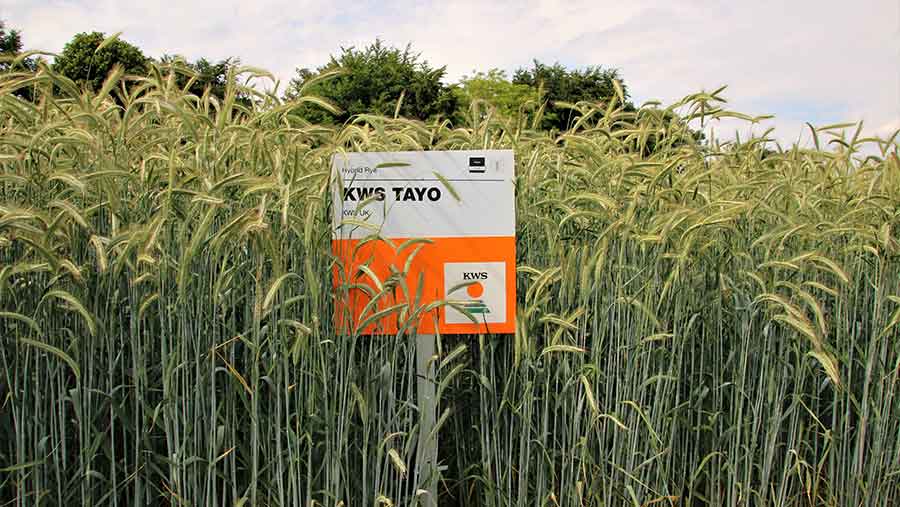Advertiser content
How hybrid rye could help decarbonise the food supply chain
 © KWS UK Ltd
© KWS UK Ltd As well as having significant advantages for growers and proven benefits in pig and poultry rations, hybrid rye could now play a key role in decarbonising the food supply chain.
Lower nitrogen requirement, simpler agronomy, greater drought tolerance and reliable 10t/ha plus yields are just some of the reasons UK arable growers should find space in their rotations for hybrid rye, believes KWS UK hybrid crops technical manager Rory Hannam.
“At a farm level, growing hybrid rye can do much to reduce the carbon footprint of production with a fertiliser requirement roughly half that of a second wheat, plus with much simpler agronomy, there are savings in input use and fuel used in applications.
“Hybrid rye has got pretty much everything going for it at the moment and our highest yielding variety KWS Tayo takes virtually all the benefits several steps forward.
“It’s a new generation PollenPlus hybrid with excellent stem stiffness, suitable for feed, flour and distilling plus it’s got a superb harvest index in terms of grains per ear which really drives yield.”
Carbon footprint benefits
According to hybrid crops product manager for KWS UK, Kate Cobbold, new research into hybrid rye as an animal feed is also showing significant carbon footprint benefits across the food supply chain from processor to consumer.
“The earlier advantages seen when rye is fed to pigs are now being added to following results seen in trials carried out by KWS and feed producer Harbro with 16,000 egg laying hens.
“The trial compared a wheat based ration with one where rye replaced the wheat by up to 25% with no material differences between the two rations being found
“From hen health through egg numbers, egg size and quality and litter waste, there were no differences between the two 8000 bird flocks.
“Historically egg producers have been reluctant to include rye, thinking that there may be a detrimental effect on egg production, in terms of egg numbers, size and shell strength.
“From this data egg producers can be confident that feeding rye to hens up to 25% has no adverse reaction.
“This benefits egg production because firstly the costs of feeding rye are lower but, much more importantly, supermarkets and other sellers of eggs are increasingly looking for products that have lower carbon footprints to meet the UK’s 2030 targets.
“The agronomic advantages of hybrid rye together with its very low nitrogen requirement mean the carbon footprint of eggs produced from rye-based feeds could be significantly lower than with conventional diets.”
Established benefits in pig production
KWS’ Dr Richard Grone, a qualified veterinarian employed by the company, says the benefits of feeding rye in pig production have been confirmed all over the world in recent years.
“Rye is already widely used in farm-produced pig diets in Denmark, Germany, Russia, Poland and Spain with growing interest in the UK.
“Trials to assess how the inclusion of rye in pig diets affects performance have shown promising results on growth rate, feed intake and Feed Conversion Ratio (FCR).
“Major improvements in performance, health, behaviour, and welfare have also been recorded in pigs from five weeks of age to fatteners, both in controlled conditions and commercial situations.”
Latest trials carried out in the UK with ABN have shown hybrid rye can successfully be included in finishing pig diets at rates of up to 60%, he explains.
“Hybrid rye can be substituted one-to-one for wheat and barley, so it offers many possibilities for feed compounders and producers.
“It can be fed as meal, liquid or pellet-based feed. It is high in dietary fibre, which promotes satiety, gut health and calm behaviour.
“It can also boost energy supply at farrowing and its levels of arabinoxylan, which is converted to butyrate in the animal’s hind gut, far exceed those of wheat.
“Rye is 2%-3% lower in crude protein than wheat, yet offers an excellent amino acid profile, particularity lysine. The hybrid rye straw also acts as a novel stimulus and helps to further reduce aggression.”
Provided by
KWS is one of the world's leading plant breeding companies combining 165 years of heritage with leading edge technology and a commitment to develop and deliver varieties with the best yields, disease resistance, physical traits and resistance to abiotic stress.
